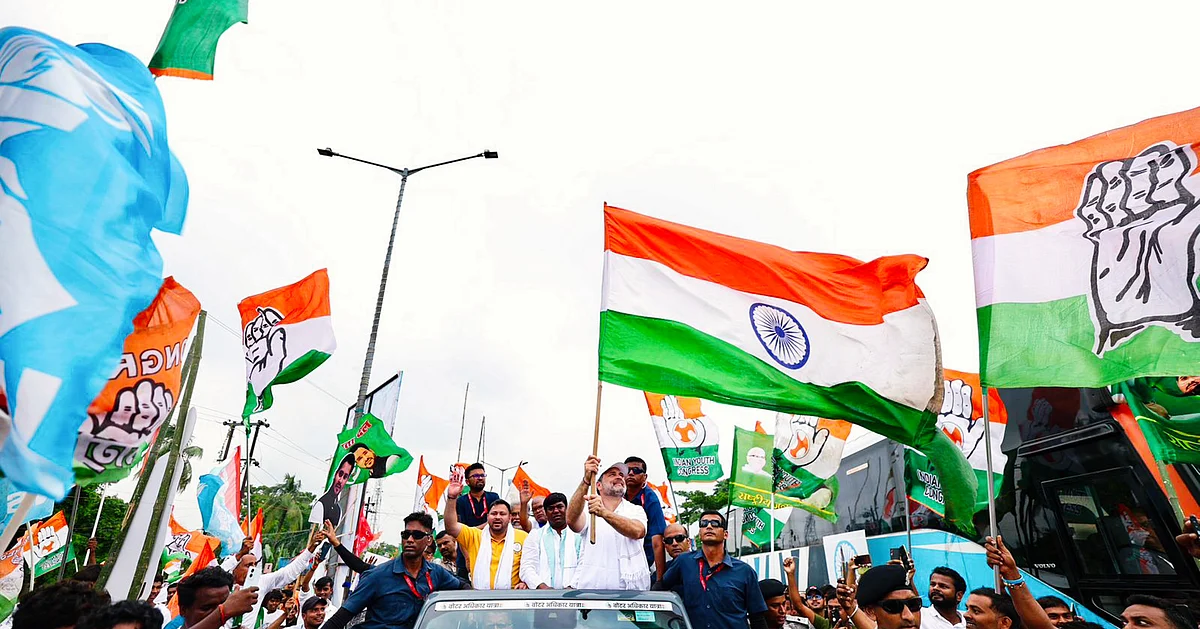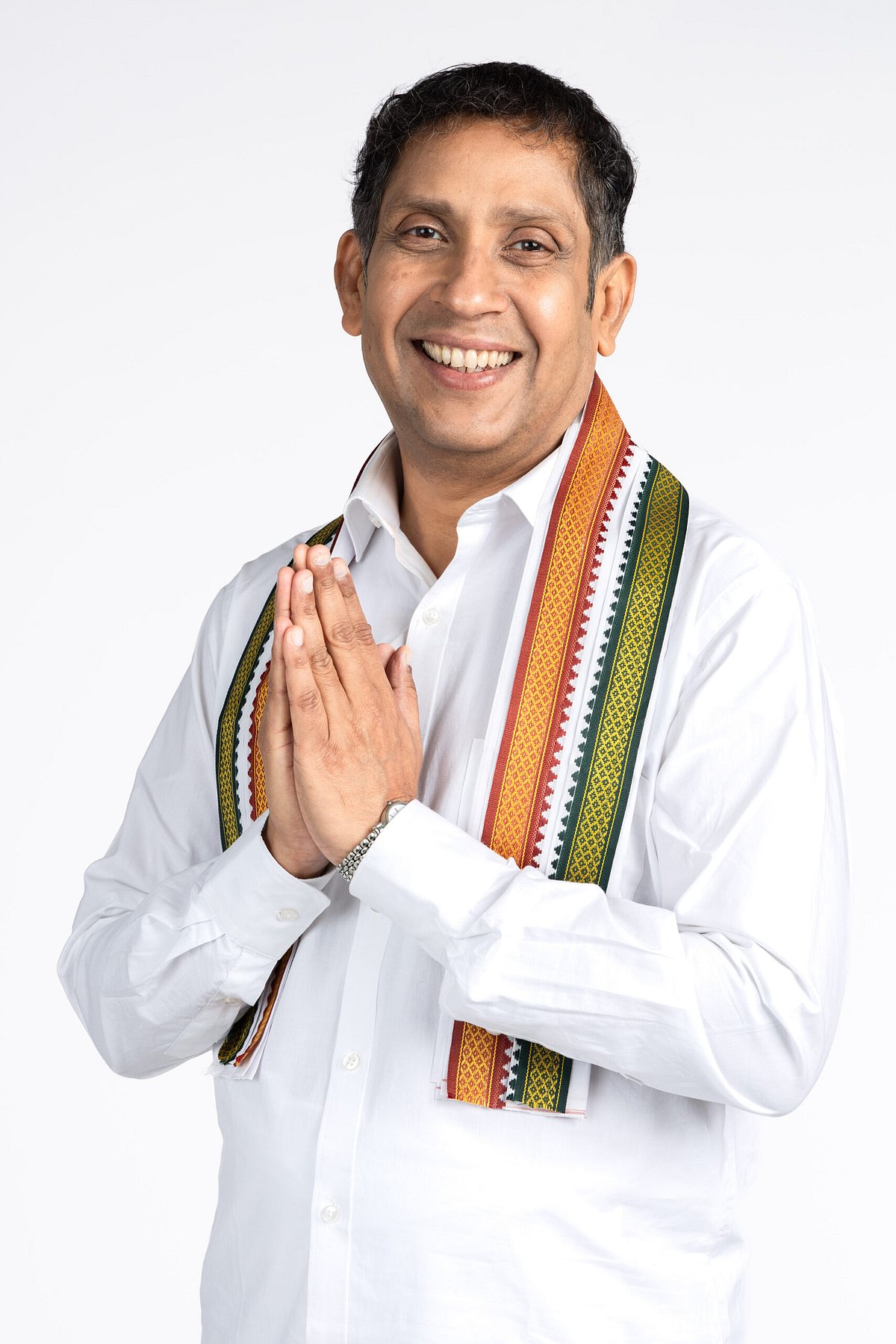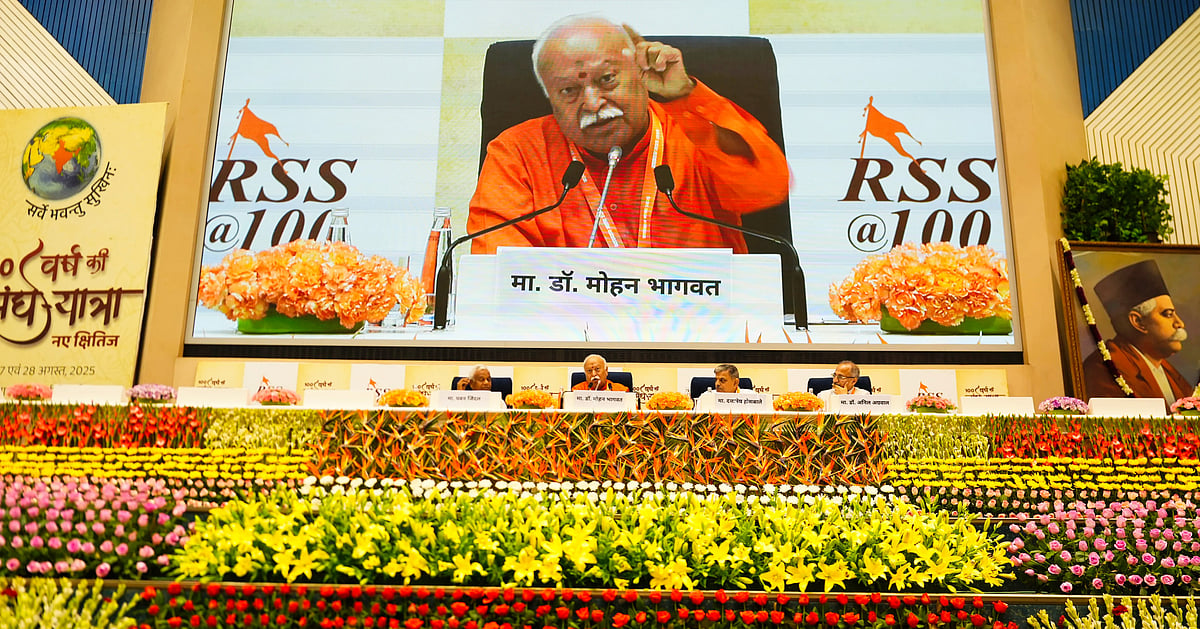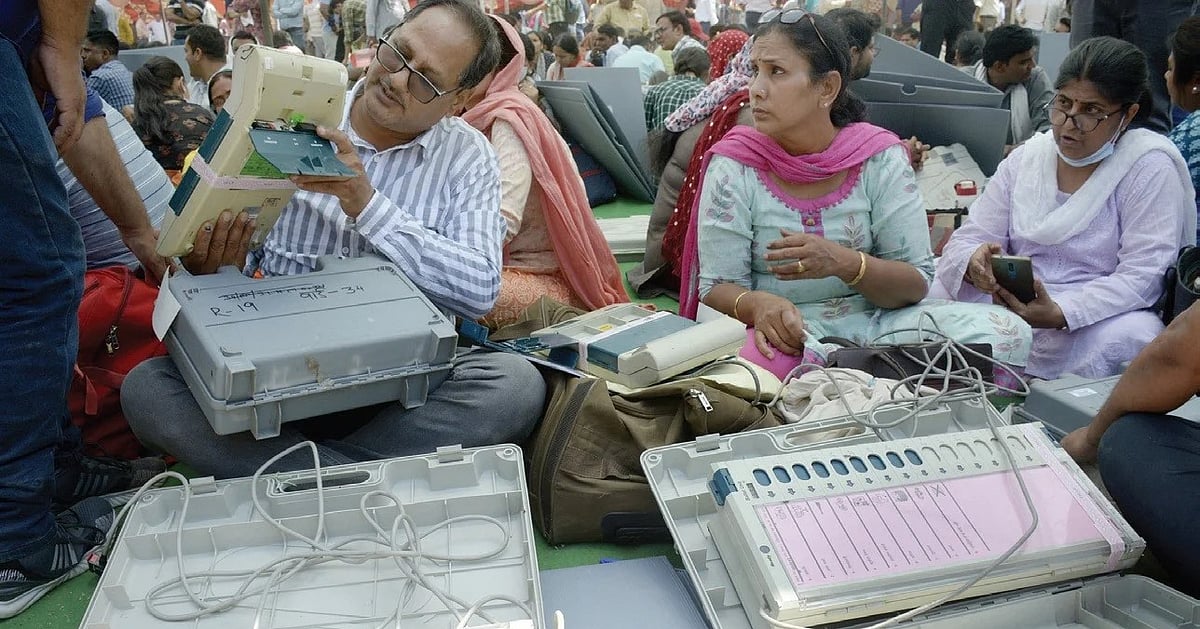National News
Up in air: Bihar voter rolls and GST 2.0

All India professional Congress president Praveen Chakravarti Looking for the truth – the brightness of the available data as well as the ‘special intensive amendment’ of the voter roll in Bihar is pushing the ECI to issue more information.
Chakraborty also worked with Prime Minister Manmohan Singh when he was preparing a blueprint for GST. Herzinder Electoral data is with them on the nuances of manipulation and the nuances of recently announced amendments in GST. Part:
The Election Commission has released machine-elective data of 65 lakh Bihar voters, whose names were removed. Do you notice a pattern in this data?
Initially, the Commission had flatly refused. After our challenge and the direction of the Supreme Court that the data was released, the Commission uploaded it, but in a fragmented manner. For any serious analysis, an integrated database of all 65 million entries is required.
Only then the pattern can be clearly identified. Instead, they gave data division in 3,000 booths, meaning 3,000 separate files. Each file should be analyzed individually. We are working on it. From our initial analysis, a very striking pattern is emerging, although I could not reveal the details yet.
Why is the Commission reluctant to share full data?
The Election Commission keeps opposing itself. First he said that the lists were already given to the booth agents. When Rahul Gandhi picked it up in Parliament, he repeated the claim, without making it clear that these were just printed bundles. As RahulYes Shown in Karnataka, the so -called list was a seven -foot high pile of papers for the single assembly section.
After our analysis and presentation, the Commission suddenly claimed “privacy issues”. This is public information – so what are they really hiding, and why are they refusing to share it?

In Maharashtra, you found a different pattern …
As RahulYes In his press conference, a pattern has been visible since 2019. Before every election, some big plays will dominate the media – Pulwama, Pakistan, Ladki sister. Survey agencies will claim a huge supporter-BJP wave. When the results came, they match the estimates completely! This cycle was consistent. At that time, many suspected EVMs. Personally, I never mentioned EVMs.
I started analyzing whether the Ladki sister campaign could explain the result in Maharashtra alone. We performed well in the Lok Sabha elections, and 157 assembly were on tracks for seats. The alliance remained unchanged. Nevertheless, within five months, our tally fell to 50. It lies that every voter who supported the Maha Vikas Aghdi (MVA) suddenly changed the sides.
When we examined the data, we came to know that our votes have not fallen – rather, they had increased. On dealing, we realized that these were new voters – more than 7 million new names appeared on rolls. When I understood the game.
Nevertheless, I was not sure that it was the BJP’s ground operation or was doing the Election Commission. After Gyanash Kumar’s press conference (on August 17), it became clear that both were involved.
The case of Bihar is currently in the Supreme Court. If it does not move there, what are the options?
It has now developed in a full political movement. When I first raised the issue of Maharashtra, many suspected. Some called it misleading. The media said that this was due to the weak organization of the Congress. Today, that scene has moved. With RahulYes‘Voter Adhikar Yatra’ is going on in Bihar.
I came back only in Chennai from making a two -hour performance, where people wanted the concept of ‘vote’ Theft‘Explained in Tamil! So yes, while the legal battle continues in the Supreme Court, this fight is big. Even BJP colleagues should reflect – if it continues, their own parties may disappear overnight. This is not the issue of Congress vs BJP. It worries about the future of Indian democracy.
Rahul Gandhi has said Abhi is baki (This is just the trailer) ‘. Should we expect another big exposure?
I can say for now: Wait.
Let’s talk about GST. You worked with Manmohan Singh when it was first proposed. Did you ever imagine that it would be called ‘Gabbar Singh Tax’ one day?
During the UPA-2, we wanted to introduce GST, but this could not happen because a state opposed it-Gujarat. Its then Chief Minister was strongly against GST. Later, when the Modi government implemented it, why did GST turn into a disaster? Because it was all about optics, no sound economics.
On 8 November 2016, Narendra Modi announced demonetisation. By December -January, it was clear that this step would wreak economic havoc. To manage the fall, he participated in GST. The decision was taken in February and the GST bill was transferred to the Lok Sabha in March 2017.
Arvind Subramaniam, the then Chief Economic Advisor and the chairman of the GST panel recommended just two tax rates and a zero rate. It was ignored. IT infrastructure was also not ready. As a result, the absurd problems cropped up – for example, Wada pav While drawing a GST rate with butter Wada pav There was another one without butter. No country in the world has ever introduced GST in such a chaotic way!
Was it implemented under Manmohan Singh, can it be different?
Explain to me with a technical concept – Laughter curve. Governments need tax revenue. The easy perception is that high taxes bring high revenue. The laffer curve argues the contrary: low tax rates can actually achieve higher revenue, as low prices increase consumption, promoting collections. That Dr. Singh’s economist was knowledge.
The second point is that GST is an indirect tax, which is called an economist ‘retrograde tax’. Why regressive? Because whether you are Mukesh Ambani, an Mainrega worker or an urban film-going, the same is done. In contrast, income tax is progressive. Therefore indirect tax rates should always be kept low. But this government did the opposite.
Now that GST rates are being reduced, will the effect be positive?
So far, this is only the matter. When implemented, we will welcome it. This has always been the UPA’s approach. A male nameYes Has been constantly advocated for a simplified GST. I was in the manifesto committee with ChidambaramYesAnd we clearly recommended to keep GST rates simple. If the government eventually implements our manifesto, we will definitely support it.
Will such changes also reduce ‘tax terrorism’ related to GST?
There are two aspects – tax rates and tax compliance. Harassment, or what we call tax terrorism arises from compliance. The more complex GST becomes, the more scope for harassment. A simple structure can definitely help reduce it.
And what about the proposed 40 percent rate – what will be the effect?
It is impossible to assess its effect until we know which goods and services fall under that slab.
Will the low GST rates not create new problems for the states?
The fundamental fault in GST is that it says towards their fiscal rights. After GST, India became the only federal democracy, where elected state governments cannot take their own taxes.
Let me give you an example. When MG Ramachandran became the Chief Minister of Tamil Nadu for the first time, he promised to launch a universal mid-day meal scheme. Officials objected that it was ineffective at a cost of Rs 200 crore. MGR insisted that this should be done. To fund it, he raised taxes on cars, alcohol and luxury goods. The scheme was successfully rolled out, and years later, the UPA government expanded the whole of India.
Such innovation is no longer possible. GST removes the ability to design and design plans based on its needs. In a country like India, with such widespread inequality among states, they should have the freedom to carry taxes compatible with their circumstances.
The Modi government had said that their revenue will not decline after GST. This guarantee lasted for five years – it is now over. Another assurance was that GST would promote GDP up to two percent. Eight years later, there was no such effect. The state is now worried that their revenue will fall rapidly.
To make cases worse, the Center has expanded continuously the use of cess. In the last decade, they have increased by 10 percent. Under GST rules, revenue is shared with states, but cess collections go entirely to the central government.
National News
U-turn of RSS chief Mohan Bhagwat

The National Swayam Sevak Association (RSS) supremo Mohan Bhagwat has demonstrated that a politician can be seen as a U-turn on the ongoing debate about retirement age, which was triggered by his first comments, firmly denying that he had ever suggested as a benchmark of retirement.
His comment believes that his earlier comments have long been seen as a veil sign for Prime Minister Narendra Modi, who turned 75 next month, as Bhagwat himself does.
In particular, the BJP’s own internal policy, as has been implemented by PM Modi and Home Minister Amit Shah, has once turned 75 years old, or she becomes a part of it. Guide circle ,
Speaking in a ‘100 -year journey’ of the incident of Sangh -New Horizon on Thursday, Bhagwat clarified his earlier comments and dismissed all interpretations, stating that he was wrongly based on his words.
Referring to a humorous anecdote by former RSS leader Moropant Pingal, God explained the intention of his previous statements. He said, “I quoted Moropant, which was very funny; he would bounce you on his chair,” he said, remembering the stories from the launch of Pingal’s biography in Nagpur.
One of the anecdotes consisted of a senior RSS leader HV Shashadari, who used to offer pingal with a shawl at the age of 75 – some Bhagwat said it was joking and not as a call for retirement.
National News
Bihar sir: More than 1.95 lakhs filed for changes; 25,000 settled

The Election Commission of India (ECI) on Thursday announced that it had received more than 1.95 lakh applications from individuals requesting the inclusion or exclusion of names from Bihar’s draft electoral roles. Of these, around 25,000 have already been addressed, Tiwari said.
Between submissions, 79 was filed by CPI (ML) -Liberation and three were filed by Rashtriya Janata Dal (RJD). Both sides are recognized as state-level political institutions in Bihar.
As the process of filing claims and objections enters in its last four days, any such application has been submitted – including any national party – BJP or Congress.
The Commission did not break how many of the total 1,95,802 requests are especially related to the inclusion or exclusion under the ‘claims and objections’ category.
In media reports, an anonymous officer was quoted, saying, “claims and objections are negligible, as compared to more than 60 million names from the draft list for various reasons.”
According to the pole body, till Monday, documentation has been obtained for 99.11 percent of the 7.24 crore voters listed in the draft role.
The draft voter list was released on 1 August as a special intensive amendment (SIR) exercise in Bihar.
In a statement released on Sunday, August 24, the ECI highlighted the claim and objection to the citizens to fix any error in the draft role and to present any of their documents that they may have left while filling their calculations.
Between 24 June and 24 August, the Commission said that 98.2 percent of the voters presented their documents within the 60-day window.
Meanwhile, the Supreme Court has directed the Commission to accept the Aadhaar Card or one of the 11 approved identity documents, demanding to be added to the election register.
In turn, the ECI has appealed to the court to have their trust in the Commission to handle the SIR process in Bihar before the upcoming elections.
National News
Assam’s identity crisis: politics of history, fear and exclusion

Assam is in troubled and upheaval today, one of the most beautiful and bounts states in India. The reason for this is ‘outsiders’, mainly Bengali Muslims-Automatically Bangladeshi is a deep-root concern among Swadeshi Assamia as Bangladeshi. The problem, however, is more complex.
Ahm integrated the Brahmaputra Valley and ruled from 1228–1826. They were migrants of Thai (Tai) origin – from Guijhou in South China, who entered through Thailand and Burma’s glory land. He maintained his ‘foreign’ pride and religion for about three centuries before assimilating into Hinduism.
This question that is a foreigner and who is not, therefore, depends on someone’s approach on a large scale. The irony is that when we celebrate his victory – such as the famous Mughal defeat of Borfukan in 1671 – we ignore the fact that the Mughal general was a Hindu Raja Ram Singh of Ajmer.
There was a turn in 1826 when the British removed the Burmese occupying the ‘Assam’, defeated the remains of Ahmas and enacted people such as new lands and wealth and gentia. Shortly thereafter, the British deliberately put a deliberate policy to settle the land and resources of the region to settle the ‘Mainland’ (Central) Indians.
The magician Bengal Presidency was part of Assam, soon educated Bengali Babus saw teaching and administrative positions, while Bengali farmers expanded farming. In 1874, one of the densely populated Eastern districts of Bengal, Sylhet was merged with Assam to make the province of an integrated Chief Commissioner with Shillong as its capital.
Neither the belly-Bengalis (large-scale Muslims) nor Assamese, mainly Hindus liked it, but both had to swallow it. Obviously, the movement and disposal within this ‘United Provinces’ was completely disqualified and the old settlers of the century get a hyper when the ‘external’ question is raised.
With the flourishing of British tea gardens, oil is being found in Digboi in 1889, and new coal mines and other resources are opened, the British found migrant labor truck loads from Bihar, Central India and Nepal to Assam’s tea gardens and coal mines, which makes serious neglect of local Assamia. A famine in Nagaon noticed that their number fell further. Today’s stress is rooted in these colonial misdeeds.
After independence and subsequent partitions, Sylhet moved to East Bengal (later Bangladesh), but there was no late-up in the flow of refugees in Assam. In 1950, Parliament passed the immigration (removal from Assam) to accept Assamese’s concerns. India’s first NRC (Civil Register of Citizen) was built in Assam based on the 1951 census. But every time riots in East Pakistan, religious oppression extended Hindu Bengalis towards Assam, West Bengal and Tripura, while poverty brought Muslims from East Pakistan to these states.
The problem of many layers of non-disgrace-speakers and their possession of fertile land and paying jobs cannot simply go. Local demonstrations against him became quite common in the 1970s – all Assam Students Union and all the Assam Gana Sangram Parishad with sometimes violence. Their demand: to find and expel illegal migrants – both Hindu and Muslim.
In 1979, a terrorist offshoot – the United Liberation Front of Asom (ULFA) – emerged for “India to Asambha Assam”. Violence was at its peak in February 1983, with the infamous Nelli massacre in which some 2,000 people, mainly Bengali Muslims, were killed in one of the worst pogroms in independent India.
The popularity of the Assam movement led by AASU and Aagsp continued until Prime Minister Rajiv Gandhi broke the Assam Agreement in August 1985. Aasu and AagSP leaders will soon form governments and take official steps to weed ‘foreigners’. However, ULFA was curved and violent, and operated on foreign soil.
Even in 1991, when I was posted in Barpeta and Nalbari as the supervisor of the Election Commission, ULFA slogans were raised – screaming ‘Indians go out’ and using other derogatory conditions. So there was heavy security, that a step could not be taken without ringing by a gun-totting guard. Over the years, batches of armed ULFA cadres began to surrender, recently led a major faction led by Arbinda Rajkhova.
The ULFA army led by more aggressive Paresh Barua still operates from China, with the only purpose to cut Assam away from India.
,
Despite the movements, the central fear persisted: Assamese could become a minority in its state. We have not even touched the issue of Bodos and many tribal groups, which are demanding our own ‘land’ free from Assamese or within or within Assam. Assamese were rapidly disappointed at the slow progress of identifying ‘foreigners’ and sometimes boiling outbreaks -sometimes boiling.
In 2013, the Supreme Court stepped into and ordered an immediate update to NRC of Assam and strictly monitored by Justice Ranjan Gogoi (an Assamia) and Justice Rohinton Fali Nariman.
The BJP, with an aggressive Hindu agenda, came to power at the Center in 2014 and accused the Congress governments on the issue of Mulayam-Peding foreigners. BJP’s state unit in Assam rode behind this combative and in 2016 seized Shakti.
Entire NRC process Grained for six yearsUnder intensive investigation and amid allegations of prejudice and massive confusion. The final update NRC for Assam was published on 31 August 2019, but no one was satisfied. It certified some 3.1 million people as real citizens in the population of 3.3 crore. It was surprising for many people that out of 19 lakh suspected foreigners, there were more Bengali Hindus than Muslims. Most Assamese did not accept this list compiled after a long drawn process costing Rs 1,603 crore by March 2022.
The governments of India and Assam were released from conclusions. Soon, soft-spoken Sarbanand Sonowal was replaced by radical Himant Biswa Sarma in 2021-a former Congress stallwart replaced the Hindutva Champion. It is during his tenure that high-granality is the rule where ‘Mass’ (Bengali Muslims) are particularly targeted.
Since 2021, he launched an aggressive campaign for the ‘encroachment’ ‘free’ government or forest land, and the record would prove that almost all such ruthless expulsions have been against Bengali speaking Muslims. He claims that he has freed 1.5 lakh bighas and is ramping on a scale ahead of next year’s assembly elections. There is no doubt that he wants to play communal cards, and there is any violence, destruction or death, but is a collateral damage.
But there is another aspect of Sarma’s plan – his alleged collusion in ‘handing over the government’ to the government and even constitutionally favorable industrialists protected tribal land. During a recent hearing, Gauhati High Court Expressed shock and disappointment Sarma’s 3,000 bigha allocation (about 4 sq km) Tribal land for a private company in Dima Hasao district.
A group of tribals in the region met the People’s Tribunal Team (Harsh Mandar, Prashant Bhushan, Vajahat Habibullah, Syeda Hamid, themselves and others) during their recent visit – to explain how illegal this action was.
Some of us visited the village of Burduar in Kamup district, where Raba Tribals talked about eviction to make us a way for some ‘Township’ project. In Golpara, the government made a prohibitory orders under Section 144 of (Old) CRPC to block our journey, but Mandar and Habibullah defined the order and visited the affected villages like Rakhishini, Hasila Beel and Asshudubi and told the authorities about bulldozers and muscles.
On 27 August, CM issued a shoot-on-vision order to the police in Dhubri district-to intimidate the minority community with population and protect “Sanatan Dharma which is in danger”.
This is the Assam of Himanta Biswa Sarma, who arrests Pawan Khera in Will and where the police issues the police until the Supreme Court is interfered against journalists Siddharth Vidarajan and Karan Thapar. It is a suspicious honor that Sarma took time out to brand our journey as “Jamaat-inspired” and allegedly stacked the Chosest interactive on us to try to disrupt Assam.
Welcome to India of Narendra Modi, Amit Shah, Yogi Adityanath and his very competent contestants, Himant Biswa Sarma.
Jawahar Sarkar A retired IAS officer and former Rajya Sabha MP
-

 IPL3 months ago
IPL3 months ago‘Any nahhi numba hai’: Furious MS Dhoni loses cool, CSK shouts at players – Watch. Cricket news
-

 Sports3 months ago
Sports3 months ago‘Is MS Dhoni fit or not?’ Cricket news
-

 IPL3 months ago
IPL3 months agoExplained: Why Punjab Kings will get two opportunities to reach IPL 2025 final
-

 National News3 months ago
National News3 months agoIndian Youth Congress started fellowship program for young lawyers
-

 IPL3 months ago
IPL3 months agoIPL 2025: Hardik Pandya hit the unique ‘Triple Century’ in T20S.
-

 IPL3 months ago
IPL3 months ago‘No, you can’t take it …’: Shreyas Iyer’s bold statement. Cricket news
-

 Sports3 months ago
Sports3 months agoHow Rohit Sharma’s bad form with BAT is damaging Mumbai Indians’ IPL 2025 campaign
-

 IPL3 months ago
IPL3 months agoAnil Kumbal on Shubman Gill: ‘Captaining India is different from the captaincy of a franchise’. Cricket news
